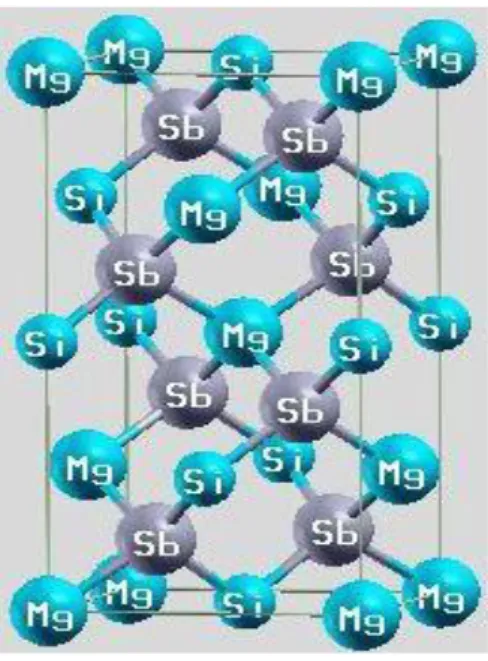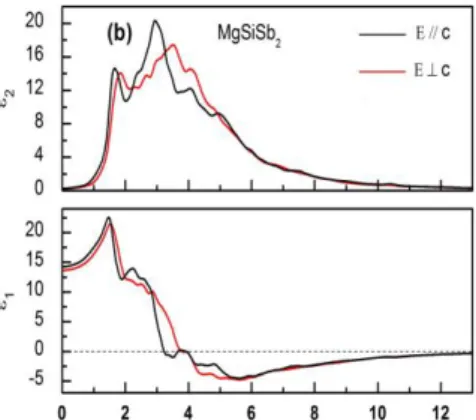First-principle study of structural and optical properties of MgSiSb2
S. Benlamari, H. Meradji, and S. Ghemid
Laboratoire LPR, Département de Physique, Faculté des Sciences, Université Badji
Mokhtar, Annaba, Algeria.
Abstract
In this work, we report the results of structural and optical properties of the ternary II-IV-V2
(MgSiSb2) chalcopyrite semiconductor using the full-potential linearized augmented plane
wave (FP-LAPW) scheme in the frame of generalized gradient approximation (GGA). The lattice parameters (a, c), the internal structure parameter, u, describing the position of Mg atom and the (c/a) ratio are optimized. The results are in good agreement with theoretical data obtained by using other methods. The linear optical properties namely the real and imaginary parts of dielectric function, refractive index and extinction coefficient are calculated. MgSiSb2
compound is observed to present very weak birefringence. 1. Introduction
The recent investigations on chalcopyrite compounds were mostly motivated by their potential use in non-linear optical applications [1], visible-light emitters [2], and photodetectors in solar cells [3-4]. The material considered in this study is MgSiSb2
chalcopyrite compound for which no experimental measurements or data are available in the literature; may be due to the difficulty to manipulate light containing elements and to beryllium toxicity.
As well, from a theoretical point of view, there are a few works related to Mg based II-IV-V2
chalcopyrites. Recently, Liwei et al. [5] have studied the structural, elastic and lattice dynamical properties of MgSiV2 (V=P, As, Sb), mainly using first principles calculations
based on density functional theory (DFT). Moreover, Jaffe and Zunger have predicted structural parameters and band gap for MgSiSb2 using self-consistent band structure methods
[6].
In the present work, we study the chalcopyrite MgSiSb2 using Full Potential Linearized
Augmented Plane Wave (FP-LAPW) [7] method, in the framework of the DFT [8], within the Generalized Gradient Approximation (GGA) to determine their structural and optical
computer package [9].The exchange and correlations interactions are treated by the gradient generalized approximation (GGA) of Perdew–Burke–Ernzerhof (PBE) [10].
In order to achieve energy eigenvalues convergence in band energies, the wave functions in the interstitial regions were expanded in plane waves with a cut-off RMT and a k vector.
Kmax=8. RMT and Kmax denote, respectively, the minimum radius of the Muffin-Tin spheres
and the magnitude of the largest k vector in the plane wave expansion.
However, Fourier expanded charge density was truncated at G max=12 (a.u). The Brillouin zone (BZ) is sampled by 40 special k points generated with 7×7×7 Monkhorst-Pack meshes [11], where the self-consistency is considered to be achieved when the total energy difference between successive iterations is less than 10-5Ryd per formula unit. Our atomic calculations are performed for Mg 2s22p63s2, Si 3s23p2 and Sb 5s25p3. The study of thermal effects was carried out within the quasi-harmonic Debye model implemented in the Gibbs program [12].
3. Results and discussion
3.1 Structural properties
MgSiSb2 ternary compound crystallize in the chalcopyrite structure belonging to the space
group I 2d (No. 221) [13]. As shown in figures 1, the atoms occupy Wyckoff positions 4a(0,0,0), 4c(0.5,0.5,0) and 8d(u,0.25,0.125); where “u” is an internal parameter denoting the dimensionless anion displacement which is given by the following expression:
- (1)
Figure1: Unit cell of MgSiSb2.
The tetrahedron is distorted along the crystal c-axis giving rise to deviations of the c/a ratio and u from the ideal values of 2.0 and 0.25 respectively.
Thus, the cell energy depends on three geometrical parameters: E = E (a, c, u). The internal parameter, u and the (c/a) rat have been optimized and used as the initial configuration to investigate the structural properties.
The equilibrium geometry and the bulk modulus are then obtained by calculating the total energy at different volumes and by fiting the results to the empirical Murnaghan equation of state [14].
Table 1 presents, for MgSiSb2 chalcopyrite compound, the calculated equilibrium lattice
constant a, c/a ratio, distortion parameter u, bulk modulus and bond lengths dII-V and dIV-V,
together with some available theoretical data for comparison [5, 6]. Both crystals are predicted to be rather close to the ideal twice a zinc-blende cell with c/a ~ 2 and u ~0.25. In general, our results are in reasonable agreement with those predicted by the pseudopotentials with planes waves approach of Ref. [5] and with those obtained by using the potential-variational-mixed-basis (PVMB) method [6]]. Moreover, our obtained distances fit rather well with the sum of the previously mentioned empirical radii for tetrahedral covalent
A c/a u B B’ dII-Sb dSi-Sb MgSiSb2 This work Ref. [15] Ref. [20] 6.429 6.348 6.221 1.870 1.828 1.878 0.280 0.287 0.281 42.327 - - 4.414 - - 2.845 2.818 - 2.615 2.541 3.3 Optical properties
In solid state physics, it is of great interest to know the different ways in which light interacts with matter. Thus, among such interactions we can cite light absorption, transmission, reflection and/or diffusion. The response of materials to alternating fields is measured through the complex dielectric function, for which it is natural to separate the real part from the imaginary one. The latter is related to the interaction of photons with electrons [16] and expressed by convention in the following way:
() = 1() + i2() (2)
To calculate the imaginary part 2(), of the dielectric function, we consider transitions from
occupied to unoccupied bands, in the electronic energy band structure, at high symmetry points in the Brillouin zone [17]. From the relationship between the real and imaginary parts of the dielectric function, known in physics as the Kramers-Kronig relation [18-20], we can evaluate the real part 1().
Figure 2, illustrates, the variation of 1() and 2() as a function of photon energy ranging
Figure 2: Calculated real ε1 (ω) and imaginary ε2 (ω) parts of the electronic dielectric function
() of MgSiSb2 for the both polarizations (Eǁc) and (Ec).
For chalcopyrite structures, there are two independent components of the dielectric function’s imaginary part; namely 2xy() and 2zz(). The first term is the average of spectra for
polarizations along the x and y directions corresponding to the electric field (E) perpendicular to the crystallographic c-axis (E⊥c) whereas the second term is related to the z direction corresponding to the electric field (E) parallel to the crystallographic c-axis ( E∥c).
Figure 2 reveals a difference, between the two components, for energies ranging from 0 to 6 eV, which implies some anisotropic behaviour for the MgSiSb2 system in this range. For
energies greater than 6 eV, there is no significant difference, between the two components. According to figure 2, we expect energy loss to be more important in X-direction than in Z-direction. The main peaks, corresponding to the real part of the electronic dielectric function, present an amplitude which is mainly generated by electronic transitions from the top of the valence band to the bottom of conduction band. Furthermore, figure 2 reveals that the MgSiSb2 system exhibits a peak at an energy of 1.51 eV, with an amplitude of 22.273.
For MgSiSb2, ║() and () display, each one, a major peak situated at energies of 2.95 eV
Figure 3: Refractive index n() and Extinction coefficient k(), for MgSiSb2 compound.
Figure 3, displays the refractive index n () and the extinction coefficient k () for MgSiSb2,
in the basal-plane and along the c-axis direction. The MgSiSb2 system is observed to present
an isotropic refractive index for low energies (0 to 2 eV). For energies greater than 2 eV, the refractive index spectrum shows a weak anisotropic behaviour between the extraordinary and the ordinary components. The latter first increase, with energy, reaching maximum values of about 4.71 at 1.56 eV and 4.84 at 1.51 eV are respectively observed, for n() and n║(). The MgSiSb2 values, of the static refractive indices and the static dielectric functions, are
summarized in Table II.
Table II : Static dielectric function and static refractive index
Crystal (0) //(0) n(0) n//(0) MgSiSb2[ Ref [6] 13.64 14.312 14.261 14.715 3.694 3.783 3.776 3.836
The extinction coefficient k (ω), which is related to the decay or damping of the incident electric field’s oscillation amplitude is observed to decrease with increasing incident photon energy.
4. Conclusion
In the present work, equilibrium structural and optic properties have been calculated, for the MgSiSb2 chalcopyrite crystal, by employing the FP-LAPW method, based on the density
The optimized lattice parameters (a, c) are in reasonable agreement with the few available theoretical data.
To achieve our compounds fundamental characteristics, we have calculated and analyzed their linear optical sensitivities. The real and imaginary parts of the dielectric function, the refractive index, the extinction coefficient and the birefringence have been determined for energies ranging from 0eV to 13eV. The MgSiSb2 dielectric function and refractive index, as
well as other important optical properties were found to be nearly isotropic at the low energy. References
[1] Levine BF (1973) Bond-Charge Calculation of Nonlinear Optical Susceptibilities for Various Crystal Structures, Phys. Rev. B 7:2600–2626.
[2] Shay JL, Schiavone LM, Buehier E, Wernick JH (1973) Spontaneous‐ and Stimulated‐Emission Spectra of CdSnP2, Appl. Phys. Lett. 43:2805.
[3] Wagner S, Shay JL, Migliorato P, Kasper HM (1974) CuInSe2/CdS heterojunction photovoltaic detectors, Appl.
Phys. Lett. 25:434.
[4] Kazmerski LL, Juang Y (1977) Vacuum‐deposited CuInTe2 thin films: Growth, structural, and electrical properties,
J. Vac. Sci. Technol. 14:769–776.
[5] Liwei Shi, Jing Hu, Yun Qin, Yifeng Duan, Ling Wu, Xianqing Yang, Gang Tang (2014) First-principles study of structural, elastic and lattice dynamical properties of chalcopyrite BeSiV2 and MgSiV2 (V = P, As, Sb), J. Alloy. Compd. 611: 210-218.
[6] Jaffe JE, Zunger A (1984) Theory of the band-gap anomaly in ABC2 chalcopyrite
semiconductors, Phys. Rev. B 4:1882-1906.
[7] Koelling DD, Harmon BN (1977) A technique for relativistic spin-polarised calculations, J. Phys. C: Sol. Stat. Phys. 10:3107.
[8] Hohenberg P, Kohn W (1964) Inhomogeneous electron gas, Phys. Rev. B 136: 864-871. [9] Blaha P, Schwarz K, Madsen GKH, Kvasnicka D, Luitz J (2001) WIEN2k. An Augmented Plane Wave + Local Orbitals Program for Calculating Crystal properties, Vienna University of Technology, Vienna, Austria.
[14] Murnaghan FD (1944) Compressibility of media under extreme pressure, Proc Natl Acad Sci USA 30: 244-255.
[15] Kittel C, (1998) Physique de l’état solide Cours et problèmes, 7nd edn, Dunod, Paris. [16] Sun J, Wang HT, Ming NB, He J, Tian Y (2004) Optical properties of heterodiamond B2CN using first-principles
calculations, Appl. Phys. Lett.84:4544
[17] Saha S, Sinha TP, Mookerjee A (2000) Electronic structure, chemical bonding, and optical properties of paraelectric BaTiO3 Phys. Rev. B 62:8828.
[18] Fox M (2001) Optical Properties of Solids, Oxford University Press, New York, p. 6. [19] Hufner S, Claessen R, Reinert F, Straub Th, Strocov VN, Steiner P, Ahuja R, Auluck S, Johansson B, Kan MA (1977) Optical properties of PdO and PtO, Phys. Rev. B 50:2128. [20] Tributsch HZ (1977) Some energetical, kinetical and catalytical considerations verified on MoS2 layer crystal surfaces, Naturforschung A. 32a: 972-985.


![Table II : Static dielectric function and static refractive index Crystal (0) // (0) n (0) n // (0) MgSiSb 2[ Ref [6] 13.64 14.312 14.261 14.715 3.694 3.783 3.776 3.836](https://thumb-eu.123doks.com/thumbv2/123doknet/11615528.303697/6.892.97.592.759.859/table-static-dielectric-function-static-refractive-crystal-mgsisb.webp)